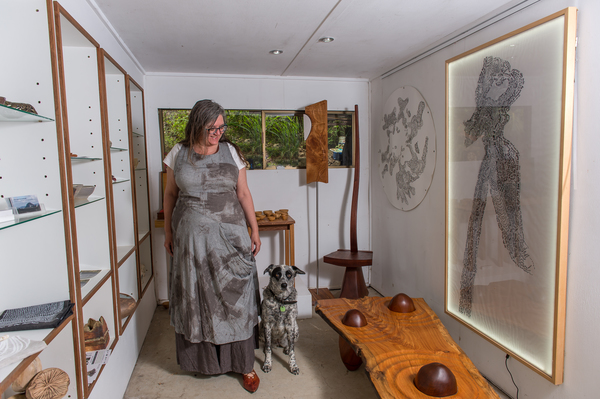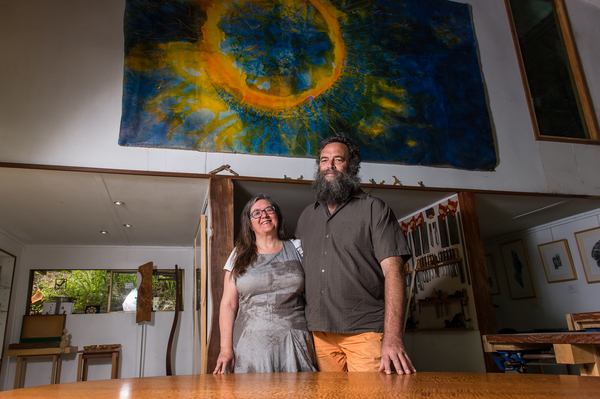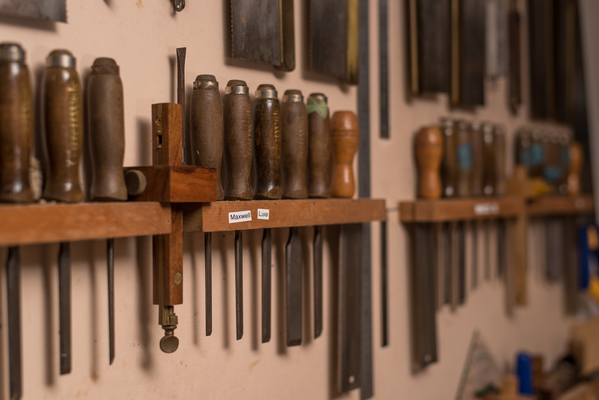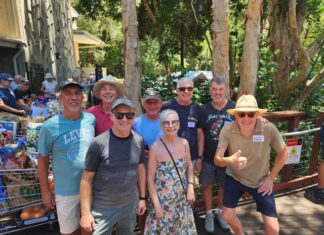By Margaret Maccoll
From the Socrates School in 400BC, groups of writers, artists and philosophers have been recorded through history gathering for discussion and collaboration and producing works of renown.
In the 1900s the Bloomsbury Group included writers Virginia Woolf and EM Forster. Andy Warhol’s 1960s studio, The Factory, brought together creatives like artist Salvador Dali, writers like Allen Ginsburg and musicians Bob Dylan and Mick Jagger.
In the Noosa hinterland, The Cooroora Institute also draws intellectuals, artists and musicians and the result is a collection of art, writing and thought-provoking ideologies.
Dr Tamsin Kerr was a senior bureaucrat working in Canberra when she first visited an earth-covered home at Cooroy with institute co-director and furniture craftsman Ross Annels, and it stuck in her mind.
It took a crisis in her life to make her realise she needed to return to it.
Tamsin was leading a social planning project working on environmental planning.
“I was doing interesting and quite radical work,” she said.
Her boss, mentor and main supporter committed suicide throwing Tamsin into emotional and career turmoil.
“I couldn’t go back into the public service, so we came here,” she said.
The couple moved to the area with small children and Tamsin gained a scholarship to do her PhD. When I finished my PhD, I didn’t want to go into academia. I wanted to put it into practice.
During her studies, Tamsin delivered talks at art events across the world. When she finished her study, she was no longer connected with Griffith University where she studied, but needed to be connected to an institution to give her the credibility to continue delivering talks.
That was how the Cooroora Institute was born. Its view of Mount Cooroora determined its title.
With both coming from an academic background they use their research-based practices to establish an environmentally sustainable centre which teaches, inspires and produces diverse works of art.
Academics, artists and musicians travel from across the country and internationally to work, share their skills and learn others while locals are attracted to the classes, Sunday music sessions and great coffee.
“The first day they wonder what they are doing here, by the second day they get it,” Tamsin said.
“They’re given permission to just sit and listen to non-human voices around them. It’s very healing. It would solve a lot of the problems in the world.”
Many people come to learn furniture-making from basic structural to sculptural pieces.
They get to design their own furniture and some are rewarded with a set of tools and shown how to look after them.
“Some people keep doing that,” Tamsin said. “They’re here every Thursday”.
Ross’ work investigates the partnerships made possible when turning natural products into more than human items.
Birdsong is a recurrent theme in his work, and his interpretative pieces translate the connection between nature and music. A couple of his chairs at Cooroora are visual interpretations of a musical note produced in birdsong with the physical attributes of the bird that produces the sound.
Some of their work is university directed. Ross is currently involved in a study with the CSIRO looking at the wood which can best be bent using steam for design. Some woods bend well and some break and the study is continuing.
The institute has become a haven for talented artists.
Next year there will be artists visiting from Hungary, Taiwan and New Zealand.
“We have people coming here from all over the world. Sometimes, they are teaching and sometimes they are artists in residence,” Tamsin said.
And the place is a collection of artworks.
Each one has a story of connection to nature from which it was created or inspired and each related to the institute in some way.
Much of their wood making projects come from the trees on the property. Having been a dairy before they arrived, the property had cleared paddocks. Tamsin and Ross planted 2000 hardwood trees when they arrived and continue to plant more to maintain a sustainable stock.
But sometimes a special tree arrives.
A large fig (Ficus Benjamina) tree which once took pride of place near the Brisbane RNA grounds was cut down to make way for development.
The tree was brought to Cooroora and artists came from around the area to work on it.
One large cross section from the trunk remains on site showing not only the size of the tree, but its adaptation to urban life. Having been continually trimmed to suit the busy location it was prevented from dropping its hanging roots which are characteristic of the species. The segment of the trunk shows how the tree had put roots down to the ground within its own trunk.
The Cooroora group created an artwork made of glass and aluminium which now sits near where the tree once did and symbolically reflects the stories it had during its life.
Seeing the world differently has become a trademark of the group, and has inspired other organisations.
While working with the National Museum of Australia Tamsin suggested they stage exhibitions look at journeys and trails in nature such as those followed by rivers and winds that are beyond human scale. She said they were adopting these themes in upcoming exhibitions.
Over the past year the institute has played host to numerous artists including jeweler and metal sculptor Bill Dorman, New Zealand wood turner Graeme Priddle, Canadian copper artist Sandra Dunn and silversmith Simona Chytil.
Indigenous elder Aunty Beverly Hand is a regular visitor conducting a language of country course which speaks to more than the human world.
Over the next couple of weeks, classes at the institute include nature writing and spoon carving and Sunday outdoor concerts are a regular event.
To be inspired and learn more visit www.cooroorainstitute.org/









